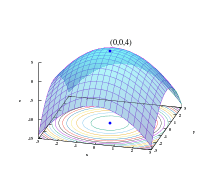Wolfe conditions
In the unconstrained minimization problem, the Wolfe conditions are a set of inequalities for performing inexact line search, especially in quasi-Newton methods, first published by Philip Wolfe in 1969.[1][2]
In these methods the idea is to find
for some smooth . Each step often involves approximately solving the subproblem
where is the current best guess, is a search direction, and is the step length.
The inexact line searches provide an efficient way of computing an acceptable step length that reduces the objective function 'sufficiently', rather than minimizing the objective function over exactly. A line search algorithm can use Wolfe conditions as a requirement for any guessed , before finding a new search direction .
Armijo rule and curvature
A step length is said to satisfy the Wolfe conditions, restricted to the direction , if the following two inequalities hold:
- i) ,
- ii) ,
with . (In examining condition (ii), recall that to ensure that is a descent direction, we have .)
is usually chosen to be quite small while is much larger; Nocedal[3] gives example values of and for Newton or quasi-Newton methods and for the nonlinear conjugate gradient method. Inequality i) is known as the Armijo rule[4] and ii) as the curvature condition; i) ensures that the step length decreases 'sufficiently', and ii) ensures that the slope has been reduced sufficiently.
Strong Wolfe condition on curvature
Denote a univariate function restricted to the direction as . The Wolfe conditions can result in a value for the step length that is not close to a minimizer of . If we modify the curvature condition to the following,
- iii)
then i) and iii) together form the so-called strong Wolfe conditions, and force to lie close to a critical point of .
Rationale
The principal reason for imposing the Wolfe conditions in an optimization algorithm where is to ensure convergence of the gradient to zero. In particular, if the cosine of the angle between and the gradient,
is bounded away from zero and the i) and ii) conditions hold, then .
An additional motivation, in the case of a quasi-Newton method, is that if , where the matrix is updated by the BFGS or DFP formula, then if is positive definite ii) implies is also positive definite.
References
- ↑ Wolfe, P. (1969). "Convergence Conditions for Ascent Methods". SIAM Review. 11 (2): 226–000. doi:10.1137/1011036. JSTOR 2028111.
- ↑ Wolfe, P. (1971). "Convergence Conditions for Ascent Methods. II: Some Corrections". SIAM Review. 13 (2): 185–000. doi:10.1137/1013035.
- ↑ Nocedal, Jorge; Wright, Stephen (1999). Numerical Optimization.
- ↑ Armijo, Larry (1966). "Minimization of functions having Lipschitz continuous first partial derivatives". Pacific J. Math. 16 (1): 1–3. doi:10.2140/pjm.1966.16.1.
Further reading
- "Line Search Methods". Numerical Optimization. Springer Series in Operations Research and Financial Engineering. 2006. pp. 30–32. doi:10.1007/978-0-387-40065-5_3. ISBN 978-0-387-30303-1.
- "Quasi-Newton Methods". Numerical Optimization. Springer Series in Operations Research and Financial Engineering. 2006. pp. 135–163. doi:10.1007/978-0-387-40065-5_6. ISBN 978-0-387-30303-1.
